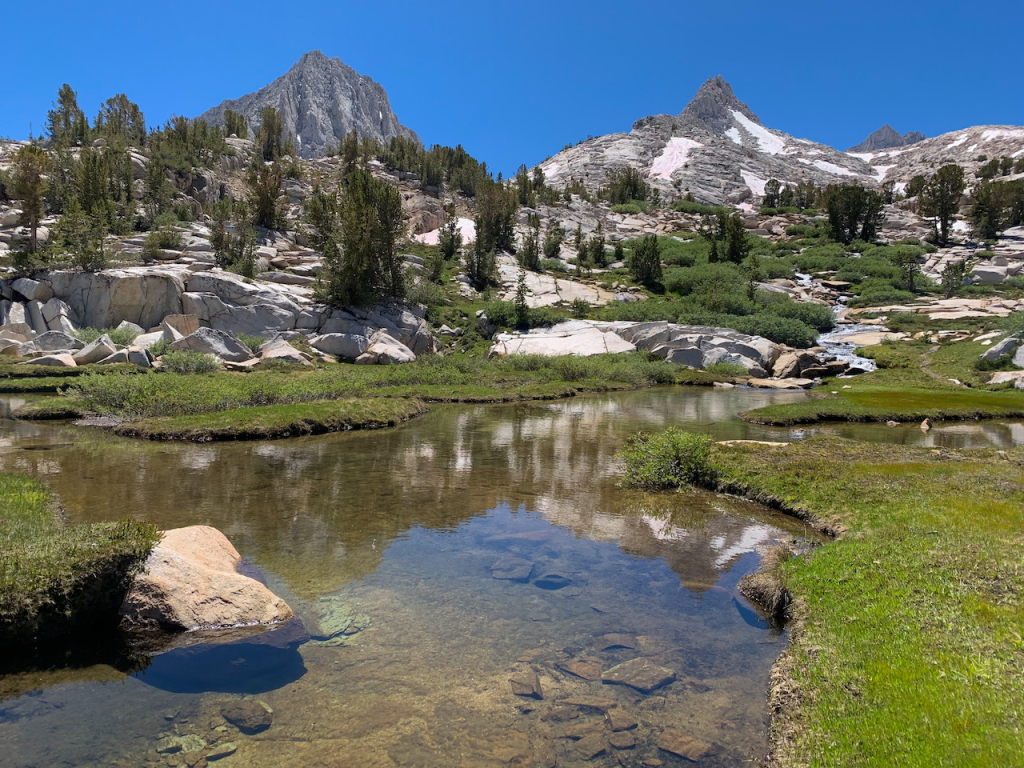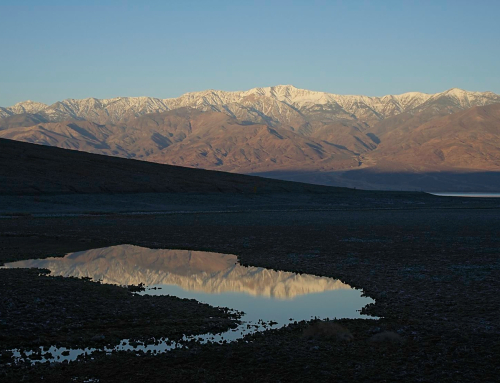If you live a short drive from good trailheads, if you are fairly fit, and if you have backpacking gear, then there is no excuse not to venture up into the mountains to get their good tidings. I do fewer backpacking trips that I’d like, but I always enjoy them, despite some aches and pains. I backpacked up into Granite Park in late August of 2019 to get photos of the headwaters of Pine Creek for a book project about Mt. Tom, but I wanted to return at the same time of year to see what the 2022-2023 record-snowfall had done. Although I was satisfied with one of the images from 2019 (below), I also wanted to get some additional photos from the same area.

Pine Creek headwaters at sunrise, Granite Park, John Muir Wilderness Area, Sierra Nevada, CA (8/30/2019)
The Pine Creek trailhead is at 7430 feet, and the area I hoped to camp at 11,600 feet, about 4200 vertical feet and 9 miles uphill. I left the trailhead around 8:15 am, hiking up through the cool, green forest of ferns, aspen, Jeffrey pine, and huge white fir trees. Unforested areas were vegetated with sagebrush, several blooming buckwheat species, and scattered beavertail cactus at the northwestern-most part of its desert range. Scarlet monkeyflower and other water-loving perennials grew in seeps and drainages above the trail. And one of my favorite trees of all – the Sierra juniper – grew out of the granitic substrate with its fibrous, cinnamon-brown, twisted trunks stretching into the sky.

Beavertail cactus, Opuntia basilaris basilaris, with remains of the Pine Creek Tungsten Mine in the background.

Scarlet monkeyflower, Erythranthe cardinalis, below a seep along Pine Creek Trail.
Climbing past the fork between Pine Creek Pass and Italy Pass near Honeymoon Lake, the forest opens up as granite becomes a more dominant feature of the landscape. Whitebark pines gradually outnumber lodgepole pines the higher you ascend.

Ponds form in a flat area just below the lower section of Granite Park. The trail ascends just right of the lower stream.
Sometime around 3 pm I found the place where I had camped in 2019. Although closer to the trail than I prefer, my tent was hidden from the trail in a depression below a small snowfield. The gap between the sand and the overhanging tongue of snow created a cool “snowcave” which served as the perfect place to escape the afternoon sun. But this year, after something like 80 feet of snow, my old campsite was under two to three feet of water!

2019 campsite, with Mt. Julius Caesar (13,220′) above.
Heading westward off the trail I soon found a good site for my tent, close to where I wanted to be at sunset, and again at first light. With the light behind the camera in the evening, there is more color and detail on Mt. Tom and the meadow. Earth’s shadow can be seen just behind the long north ridge of Mt. Tom, with the pinkish anti-twilight arch, also known as the Belt of Venus, just above the shadow.

Evening twilight view, Granite Park, John Muir Wilderness Area, Sierra Nevada, CA
But capturing the first direct rays of the morning sun at the low part of the horizon is also pretty dramatic.

Granite Park, John Muir Wilderness Area, Sierra Nevada, CA
During the day I wandered around Granite Park and hiked up to Italy Pass. The view back into Granite Park from the pass at 12,400 feet is impressive, with a vast expanse of Sierra peaks visible to the south. Mt. Tom (13,658′) is at far left; Mt. Humphreys (13,992′) is the pointy peak in the center. Just to the right of Mt. Humphreys are the peaks around Bishop Pass.

View south from Italy Pass, Granite Park, John Muir Wilderness Area.
Flowers were blooming in profusion, and cracks in the weathered and watered granite burst with penstemons, pussy-paws, and even the occasional glandular lewisia, a close relative of miner’s lettuce and bitterroot.

Glandular lewisia, Lewisia glandulosa, Granite Park.

Alpine or Davidson’s penstemon, Penstemon davidsonii, Granite Park.

Winter snowpack remains along the northern edge of a small lake at 11,600 feet, with Mt. Humphreys in the background, Granite Park. All lakes were ice-free in late August 2019.
One of my favorite spots in Granite Park is on the eastern edge of the basin at an overlook of Chalfant Lakes Basin. There is an impressive expanse of glacially-polished granite here where Pleistocene rivers of ice crept eastward from the roof of the Sierra. The most recent Tahoe and Tioga glacial periods (from 170,000 to around 20,000 years ago) left lateral moraine deposits still visible on the floor of Round Valley miles below the Pine Creek Trailhead. Glacial polish and a snowfield lingering into late summer with three-foot deep suncups signify the glacial history here. In our present warming climate it is hard to imagine ice hundreds of feet high here, but the form of the U-shaped valleys of Granite Park and Chalfant Lakes Basin, the arêtes that tower over the entire western edge of Granite Park, and the glacially-polished granite at the low point of its eastern edge portray clearly this area’s icy past.

Glacial polish reflects the morning sun, above Chalfant Lakes Basin (8/31/2019).

Deep Snowcups at eastern edge of Granite Park.
The massive winter left snowfields lingering over the inlet to the large meadow in upper Granite Park. I felt very fortunate to be here when I was because the thin bridge of melting ice over the bottom of the inlet was about to go at any minute, and it definitely added an interesting abstract structural element to the photo images.

Snowfield melting above the bottom of a stream, Granite Park.

Water cascades beneath an ice formation, Granite Park.
Another good aspect of revisiting Granite Park in late August years apart is getting to experience a different part of the lunar cycle. I was here this year just a few nights before the full “blue supermoon.” With the snow and pale granite reflecting light from the nearly full moon, it was surprisingly bright. But in 2019, there was no moon to compete with the Milky Way, and I was able to capture one of my favorite images of our galaxy stretched above the rough granite spires of Granite Park.

Moonrise to the southeast from Granite Park.

Moonlit mountain landscape and tent, Granite Park.

The Milky Way arcs above the southwest horizon of Granite Park, John Muir Wilderness Area, Sierra Nevada, CA (8/30/2019).






